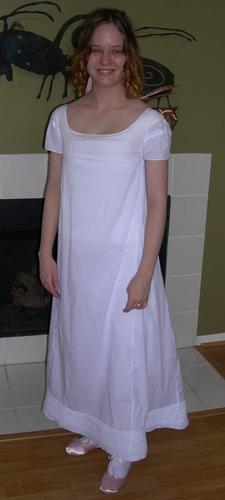I mean, yes. We know that pantalets were coming into use (split crotch of course), and everybody points to the existing bodiced petticoats out there. But like I said, I'm still not satisfied.
Because you can't wear that many bodiced petticoats at once. And they're not uncommon, but they're not that common. And I don't think I've seen a single historic sketch, print, or painting that shows them in use (please tell me if you've got one, because I'd kill to have one for my presentation next week).

Gowns of 1795, when extra pouf was still in fashion
From the English fashion magazine Gallery of Fashion
And yet, I know that I once read a brief historic quote where someone was complaining about the "young things of today going around in as few as one or two petticoats" (it's a paraphrase. Lord knows I also didn't memorize it). Adequate petticoats were required for decency, sufficient pouf in your silhouette, and warmth. This one person, at least, thought that three was a bare minimum.

Satirical "Three Graces in a High Wind" image lampooning inadequate undies
So if the ladies of the Regency/Empire/Federal era (say around 1795-1820) needed to add up more petticoats, what was the answer?

I've spent extra time looking at this over the past week because I am giving my "UnderWhere? in 1800" presentation at work at the end of the month, and I need to have something to say about the issue. I have come to some hesitant conclusions.
I am going to go with the assumption that my memory of this quote is correct and say that three is a good set of petticoats. Say I wear one bodiced petticoat, because we know they aren't excessively common, and any more than that is going to result in some bulking around the shoulders.
What of the other two petticoats?

1813 Fashion plate from La Belle Assemblee
Wearing a standard petticoat around the waist, outside your corset seems like it might create a funny-looking line in your costume, but I have seen people get away with it successfully, provided you don't wear too many.
But I've decided that it must be acceptable to where petticoats underneath your corset in order to get enough of them. This practice went back through the 18th century and would have been considered standard up until at least 1795 when waistlines and bustlines became one-in-the-same.
In the well-known print "Fashion Before Ease," from the last quarter of the 18th century, you can see that this woman is clearly wearing several petticoats, her false rump, and her pockets underneath her stays (corset). From personal experience, I can only guess that her waist was feeling quite squished with all of those under a tight pair of stays.

Fashion Before Ease
The same arrangement is seen on madame below in a 1791 satirical image.

And this 1823 image (now into the Empire era) seems to suggest that this woman could be wearing one underneath hers as well. If you look at her hem, you can decorative tucks. At this point in time, chemises were generally unadorned at the hem, though some decoration was appearing at the neckline.

Book of English Trades, 1823-4
This 1809 French Engraving is less clear. The woman on the right appears to be wearing just her chemise under her stays. But the woman on the left could be seen as wearing a petticoat as well since again there seems to be some ornamentation along her hemline.

However, the woman in the 1810 image "Progress of the Toilet" is planning to depend on petticoats outside her corset, rather than underneath.

"Progress of the toilet," 1810
So where does all this leave me?
Petticoats, like all clothing, would have been heavily influenced by the status, living/working conditions, geographic location, and familial tradition of the wearer, making a standardized practice for garment wear unlikely. This holds especially true in the absence of a popular form of media or other distribution source (such as fashion magazines, which were not commonly circulated and did not show underwear during this period) that would teach women the "right" way to wear their petticoats.
The best any of us can do in recreating this era of costuming is stick to what we know of preceeding practices, written accounts, and the few existing images.
I am standing by my theory that some petticoats continued to be worn under the stays, and I am making myself a new, leightweight white petticoat for the purpose. The best I can do is point to the images I've got and hope that something more conclusive falls in my lap one day.
My thanks to www.pemberly.com, who supplied me with most of my images.



No comments:
Post a Comment